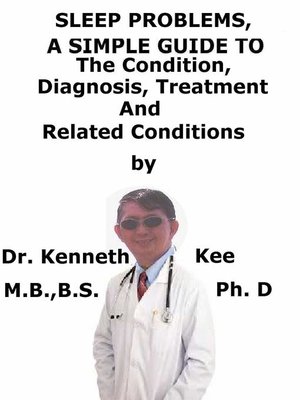Sleep Problems, a Simple Guide to the Condition, Diagnosis, Treatment and Related Conditions
ebook
By Kenneth Kee

Sign up to save your library
With an OverDrive account, you can save your favorite libraries for at-a-glance information about availability. Find out more about OverDrive accounts.
Find this title in Libby, the library reading app by OverDrive.



Search for a digital library with this title
Title found at these libraries:
| Loading... |
This book describes Sleep Problems, Diagnosis and Treatment and Related Diseases
Sleep is something which every one needs.
It helps to relax the mind and permits the body to rest and rejuvenate itself.
Sleep is depicted as a state of awareness or dynamic activity which provides the body time to rest and build up strength while the brains continue working.
Sleep has 4 phases:
1. During the first stage N1, the sleeping is light and a person can be easily awakened.
At this N1 stage, the muscle actions and eye movements are very slow.
Alpha waves of 8-13 Hz (awake stage) start to alter to the theta waves of 4-7 Hz on the EEG.
Often when a person is awakened, sudden muscle contractions happen as if the person is falling off the bed.
N1 only persists for up to 10 minutes and is the easiest stage to wake a person.
During this stage, the body starts to relax by reducing its heart rate, blood pressure, eye movements, and respiratory rate.
Muscle activity also diminishes, even though twitches can often be observed.
If brain activity is measured with an electroencephalogram (EEG), the pattern will reveal slowing of alpha waves, the rhythmic patterns normally seen while awake, and lower voltage waves.
2. At N2 stage, eye movements cease and brain waves become slower with intermittent burst of rapid waves termed "sleep spindles".
Muscle activity as measured by EMG diminishes, and consciousness of the external environment disappears.
This stage involves 45–55% of total sleep in adults.
This N2 sleep stage continues the body relaxation with further reductions in heart rate, blood pressure, respiratory rate, and muscle action.
The eye movements have stopped by this phase.
In order to further reduce energy needs, body temperature also falls by about 1 to 2 degrees F.
An EEG done during this stage will often reveal K waves, or long, high voltage waves persisting up to 1 second, and sleep spindles or periods of low voltage and high frequency spikes as telltale signs.
Generally, this stage persists about 10 to 25 minutes
3. In stage N3, delta waves of 0.5 to 2 Hz begin to appear.
These are very slow brain waves that are interspersed with smaller, faster waves.
Sleep at stages 3 is regarded as deep sleep where there is no more eye movement or muscle activity.
It is hard to wake up a person who is in stage 3 of sleep.
People who are awakened during deep sleep may feel temporary disorientation.
It is also during this deep sleep stage that children have bedwetting, night terrors, or sleepwalking.
This final stage of non-REM sleep, N3, is the deepest stage of sleep and it is the very difficult to awaken a person.
Bodily functions have relaxed to their slowest point during this stage.
Muscle activity persists to decrease, but slight muscle movements are still possible in this stage.
The typical EEG reveals a high voltage, slow and irregular pattern termed delta waves.
N3 sleep stage persists for about 20 to 40 minutes before transitioning to the REM sleep stage
4. REM sleep is the last sleep stage where breathing is faster, more shallow and irregular.
The eyes jerk rapidly (rapid eye movements) in different directions with the limb muscles becoming paralyzed for a short period of time.
During this stage, the heart rate rises, blood pressure rises, and penile erections happen among men.
REM sleep is different from the other stages of sleep, as the brain becomes more active during this phase almost to the degree or even more so than while conscious.
Dreams happen during REM sleep...






